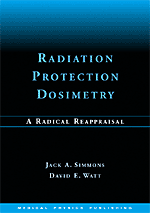
Radiation Protection Dosimetry: A Radical Reappraisal
Author: Jack Simmons & David WattISBN: 9780944838877 ISBN10: 0944838871
Published: 1999 | 160 pp |
OUT OF PRINT
International Journal of Radiation Biology | Vol. 75, No. 10 (1999)
“The core of this short book is chapter 5, which extends biophysical modelling results originated in the 1980s. Evidence is presented that a main determinant of charged particle effectiveness for killing mammalian cells is λ, the mean free path for linear primary ionization, essentially the average distance between energy deposition events along the primary track. For many different radiations, maximum effectiveness as the energy varies is found for λ = 1.8 nm, a value the authors interpret geometrically, in terms of DNA double strand breaks (DSB). They suggest that delta ray action rarely produces DSB at locations away from a primary ion track, and that the average energy per delta ray has little biological importance. They argue that therefore two energy-based quantities, LET and dose, should be replaced by λ and particle flux in biophysical analyses and, in a radical reappraisal of radiation protection methodology, weighting factors should be replaced by bioeffect cross sections.
“Earlier chapters emphasize historical aspects of radiation protection. In chapter 4 the authors survey other biophysical models that are related to their own. It is very useful to have various models thus interconnected. However, the model descriptions are introductory rather than definitive, and the reader may be perplexed by discrepancies between equations and text unless the original papers are consulted.
“Chapter 6 briefly describes an overall model of radiation damage, with most endpoints taken to be directly proportional to the number of unrepaired DSB. For example, the authors analyze dose-response relations and dose-rate effects for cell inactivation, assuming one-track action, linear first-order DSB repair, variation of radiosensitivity during the cell cycle, and DSB fixation at an M checkpoint. The treatment has a number of quite puzzling features. For example, the authors state that, in the case of acute irradiation, linear log-survival holds for synchronized cells (i.e., no shoulder, even at low LET), and also holds for asynchronous cells (e.g., cell population heterogeneity in radioresponse does not lead to resistant tails).
“The authors strongly oppose linear no-threshold extrapolations in risk assessment, and they survey some of the relevant epidemiological literature on carcinogenesis. They state that their approach, replacing dose by fluence, would ‘effectively remove’ the linear no-threshold hypothesis, but do not adequately explain why.
“In all, this is an interesting, highly individualistic book well worth reading.”
R.K. Sachs
Department of Mathematics and
Department of Physics
University of California at Berkeley
CA 94720
USA


